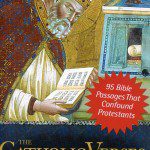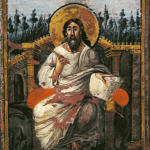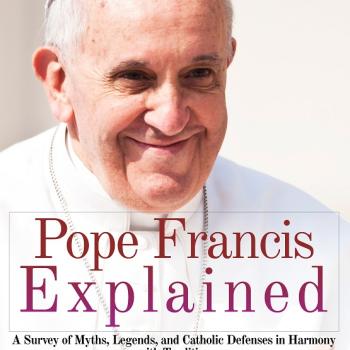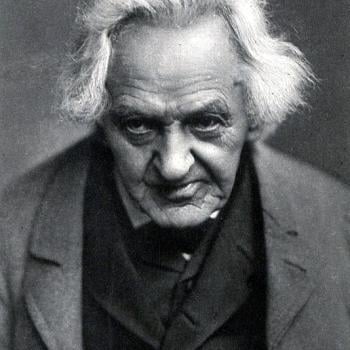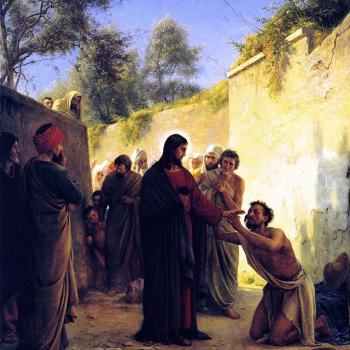Jesus chose Judas as His disciple, even though He knew the future, and he was truly an Apostle (Matthew 10:1,4, Mark 3:14, John 6:70-71, Acts 1:17). Likewise, St. Paul, in addressing elders (Acts 20:17) states that the Holy Spirit Himself has made them bishops (RSV, guardians, Greek,episkopos – Acts 20:28), yet from among these very same men, heretics and schismatics would arise (Acts 20:30). He echoes this thought in the parable-like verse 2 Timothy 2:20 (see also 2:15-19).
Protestants often cite Jesus’ analogy of sheep and shepherd (John 10:1-16; cf. 2 Timothy 2:19, 1 John 2:19), who know each other (10:14), as evidence that the Church consists of the elect only. Yet the analogy breaks down when we find that Scripture also applies the term sheep to the unsaved reprobate (Psalm 74:1), the straying (Psalm 119:176), Israel as a nation (Ezekiel 34:2-3,13,23,30), and, indeed, all men (Isaiah 53:6).
Other passages which presuppose a visible, identifiable, “concrete” Church include Matthew 18:15-17, in which believers are exhorted by our Lord to take errant and obstinate brothers to the church, which will then determine the appropriate verdict. It would be contrary to the tenor of the New Testament if this were a reference to a local church alone – even apart from the utterly impractical consequences of such a scenario (where the sinner would simply attend another denomination and move on with his life, as is tragically all too often the case today).
And St. Paul, in 1 Timothy 3:15, describes the “church of the living God” as “the pillar and bulwark of the truth.” This statement is similarly almost nonsensical in the context of competing and often contradictory denominations. Where would a sincere, uninformed, unsophisticated religious seeker go to find this certain truth? Only within the sphere of a serious attempt at actual visible oneness of doctrine can this verse attain any pragmatic possibility.
It is also incorrect to regard St. Paul as some kind of spiritual “lone ranger,” on his own with no particular ecclesiastical allegiance, since he was commissioned by Jesus Himself as an Apostle. In his very conversion experience, Jesus informed Paul that he would be told what to do (Acts 9:6; cf. 9:17). He went to see St. Peter in Jerusalem for fifteen days in order to be confirmed in his calling (Galatians 1:18), and fourteen years later was commissioned by Peter, James, and John (Galatians 2:1-2,9). He was also sent out by the Church at Antioch (Acts 13:1-4), which was in contact with the Church at Jerusalem (Acts 11:19-27). Later on, Paul reported back to Antioch (Acts 14:26-28).
The New Testament refers basically to three types of permanent offices in the Church (Apostles and Prophets were to cease): bishops (episkopos), elders (presbyteros, from which are derived Presbyterian and priest), and deacons (diakonos). Bishops are mentioned in Acts 1:20, 20:28, Philippians 1:1, 1 Timothy 3:1-2, Titus 1:7, and 1 Peter 2:25. Presbyteros (usually elder) appears in passages such as Acts 15:2-6, 21:18, Hebrews 11:2, 1 Peter 5:1, and 1 Timothy 5:17. Protestants view these leaders as analogous to current-day pastors, while Catholics regard them as priests. Deacons (often, minister in English translations) are mentioned in the same fashion as Christian elders with similar frequency (for example, 1 Corinthians 3:5, Philippians 1:1, 1 Thessalonians 3:2, 1 Timothy 3:8-13).
As is often the case in theology and practice among the earliest Christians, there is some fluidity and overlapping of these three vocations (for example, compare Acts 20:17 with 20:28; 1 Timothy 3:1-7 with Titus 1:5-9). But this doesn’t prove that three offices of ministry did not exist. For instance, St. Paul often referred to himself as a deacon or minister (1 Corinthians 3:5, 4:1, 2 Corinthians 3:6, 6:4, 11:23, Ephesians 3:7, Colossians1:23-25), yet no one would assert that he was merely a deacon, and nothing else. Likewise, St. Peter calls himself a fellow elder (1 Peter 5:1), whereas Jesus calls him the rock upon which He would build His Church, and gave him alone “the keys of the kingdom of heaven” (Matthew 16:18-19). These examples are usually indicative of a healthy humility, according to Christ’s injunctions of servanthood (Matthew 23:11-12, Mark 10:43-44).
Upon closer observation, clear distinctions of office appear, and the hierarchical nature of Church government in the New Testament emerges. Bishops are always referred to in the singular, while elders are usually mentioned plurally. The primary controversy among Christians has to do with the nature and functions of both bishops and elders (deacons have largely the same duties among both Protestants and Catholics).
Catholics contend that the elders/presbyters in Scripture carry out all the functions of the Catholic priest:
1) Sent and Commissioned by Jesus (the notion of being called): Mark 6:7, John 15:5, 20:21, Romans 10:15, 2 Corinthians 5:20.
2) Representatives of Jesus: Luke 10:16, John 13:20.
3) Authority to “Bind” and “Loose” (Penance and Absolution): Matthew 18:18 (compare Matthew 16:19).
4) Power to Forgive Sins in Jesus’ Name: Luke 24:47, John 20:21-23, 2 Corinthians 2:5-11, James 5:15.
5) Authority to Administer Penance: Acts 5:2-11, 1 Corinthians 5:3-13, 2 Corinthians 5:18, 1 Timothy 1:18-20, Titus 3:10.
6) Power to Conduct the Eucharist: Luke 22:19, Acts 2:42 (compare Luke 24:35, Acts 2:46, 20:7, 1 Corinthians 10:16).
7) Dispense Sacraments: 1 Corinthians 4:1, James 5:13-15.
8) Perform Baptisms: Matthew 28:19, Acts 2:38,41.
9) Ordained: Acts 14:23, 1 Timothy 4:14, 5:23.
10) Pastors (Shepherds): Acts 20:17,28, Ephesians 4:11, 1 Peter 5:1-4.
11) Preach and Teach: 1 Timothy 3:1-2, 5:17.
12) Evangelize: Matthew 16:15, 28:19-20, Mark 3:14, Luke 9:2,6, 24:47, Acts 1:8.
13) Heal: Matthew 10:1, Luke 9:1-2,6.
14) Cast Out Demons: Matthew 10:1, Mark 3:15, Luke 9:1.
15) Hear Confessions: Acts 19:18 (compare Matthew 3:6, Mark 1:5, James 5:16, 1 John 1:8-9; presupposed in John 20:23).
16) Celibacy for Those Called to it: Matthew 19:12, 1 Corinthians 7:7-9,20,25-38 (especially 7:35).
17) Enjoy Christ’s Perpetual Presence and Assistance in a Special Way: Matthew 28:20.
Protestants – following Luther – cite 1 Peter 2:5,9 (see also Revelation 1:6) in order to prove that all Christians are priests. But this doesn’t exclude a specially-ordained, sacramental priesthood, since St. Peter was reflecting the language of Exodus 19:6, where the Jews were described in this fashion. Since the Jews had a separate Levitical priesthood, by analogy 1 Peter 2:9 cannot logically exclude a New Testament ordained priesthood. These texts are concerned with priestly holiness, as opposed to priestly function. The universal sense, for instance, never refers to the Eucharist or sacraments. Every Christian is a priest in terms of offering the sacrifices of prayer (Hebrews 13:15), almsgiving (Hebrews 13:16), and faith in
Jesus (Philippians 2:17).
Bishops (episkopos) possess all the powers, duties, and jurisdiction of priests, with the following important additional responsibilities:
1) Jurisdiction over Priests and Local Churches, and the Power to Ordain Priests: Acts 14:22, 1 Timothy 5:22, 2 Timothy 1:6, Titus 1:5.
2) Special Responsibility to Defend the Faith: Acts 20:28-31, 2 Timothy 4:1-5, Titus 1:9-10, 2 Peter 3:15-16.
3) Power to Rebuke False Doctrine and Excommunicate: Acts 8:14-24, 1 Corinthians 16:22, 1 Timothy 5:20, 2 Timothy 4:2, Titus 1:10-11.
4) Power to Bestow Confirmation (the Receiving of the Indwelling Holy Spirit): Acts 8:14-17, 19:5-6.
5) Management of Church Finances: 1 Timothy 3:3-4, 1 Peter 5:2.


